
Left: mLg computed using the IASPEI formula. Center: mLg residuals versus epicentral distance ; the values used for the trimmed mean magnitude estimate are indicated. Right: residuals as a function of distance and azimuth.
The ANSS event ID is tx2025ntfduu and the event page is at https://earthquake.usgs.gov/earthquakes/eventpage/tx2025ntfduu/executive.
2025/07/14 14:13:00 32.069 -103.728 7.6 3.2 New Mexico
USGS/SLU Moment Tensor Solution
ENS 2025/07/14 14:13:00.0 32.07 -103.73 7.6 3.2 New Mexico
Stations used:
GM.NMP01 GM.NMP02 GM.NMP41 GM.NMP44 GM.NMP45 TX.MNHN
TX.PB06 TX.PB11 TX.PB40 TX.PECS
Filtering commands used:
cut o DIST/3.3 -30 o DIST/3.3 +30
rtr
taper w 0.1
hp c 0.05 n 3
lp c 0.15 n 3
Best Fitting Double Couple
Mo = 5.43e+20 dyne-cm
Mw = 3.09
Z = 9 km
Plane Strike Dip Rake
NP1 41 63 -127
NP2 280 45 -40
Principal Axes:
Axis Value Plunge Azimuth
T 5.43e+20 10 157
N 0.00e+00 33 60
P -5.43e+20 55 262
Moment Tensor: (dyne-cm)
Component Value
Mxx 4.39e+20
Mxy -2.17e+20
Mxz -5.11e+19
Myy -9.01e+19
Myz 2.90e+20
Mzz -3.49e+20
##############
######################
############################
#############################-
##############################----
#######-----------------#######-----
####-------------------------###------
##------------------------------#-------
-------------------------------####-----
-------------------------------#######----
----------- ----------------#########---
----------- P ---------------###########--
----------- --------------#############-
-------------------------###############
-----------------------#################
--------------------##################
-----------------###################
--------------####################
--------######################
-################### #####
################# T ##
#############
Global CMT Convention Moment Tensor:
R T P
-3.49e+20 -5.11e+19 -2.90e+20
-5.11e+19 4.39e+20 2.17e+20
-2.90e+20 2.17e+20 -9.01e+19
Details of the solution is found at
http://www.eas.slu.edu/eqc/eqc_mt/MECH.NA/20250714141300/index.html
|
STK = 280
DIP = 45
RAKE = -40
MW = 3.09
HS = 9.0
The NDK file is 20250714141300.ndk The waveform inversion is preferred.
Given the availability of digital waveforms for determination of the moment tensor, this section documents the added processing leading to mLg, if appropriate to the region, and ML by application of the respective IASPEI formulae. As a research study, the linear distance term of the IASPEI formula for ML is adjusted to remove a linear distance trend in residuals to give a regionally defined ML. The defined ML uses horizontal component recordings, but the same procedure is applied to the vertical components since there may be some interest in vertical component ground motions. Residual plots versus distance may indicate interesting features of ground motion scaling in some distance ranges. A residual plot of the regionalized magnitude is given as a function of distance and azimuth, since data sets may transcend different wave propagation provinces.

Left: mLg computed using the IASPEI formula. Center: mLg residuals versus epicentral distance ; the values used for the trimmed mean magnitude estimate are indicated.
Right: residuals as a function of distance and azimuth.

Left: ML computed using the IASPEI formula for Horizontal components. Center: ML residuals computed using a modified IASPEI formula that accounts for path specific attenuation; the values used for the trimmed mean are indicated. The ML relation used for each figure is given at the bottom of each plot.
Right: Residuals from new relation as a function of distance and azimuth.

Left: ML computed using the IASPEI formula for Vertical components (research). Center: ML residuals computed using a modified IASPEI formula that accounts for path specific attenuation; the values used for the trimmed mean are indicated. The ML relation used for each figure is given at the bottom of each plot.
Right: Residuals from new relation as a function of distance and azimuth.
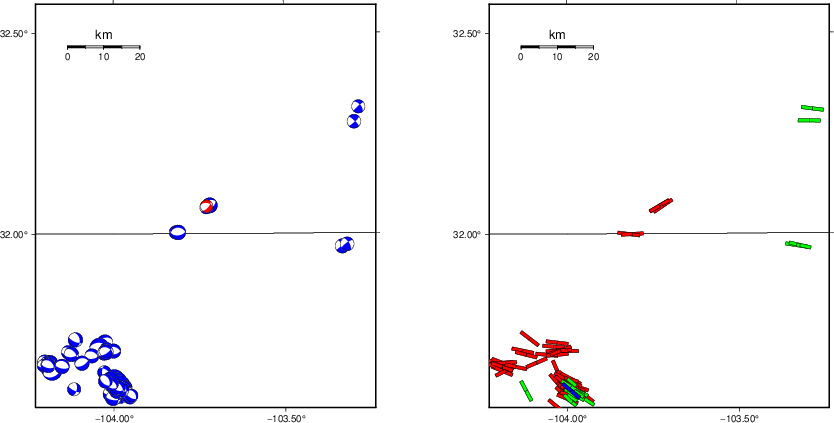 |
The focal mechanism was determined using broadband seismic waveforms. The location of the event (star) and the stations used for (red) the waveform inversion are shown in the next figure.
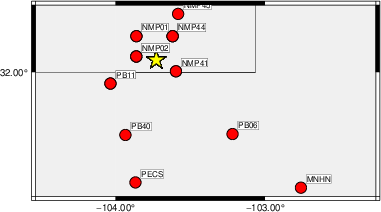
|
|
|
The program wvfgrd96 was used with good traces observed at short distance to determine the focal mechanism, depth and seismic moment. This technique requires a high quality signal and well determined velocity model for the Green's functions. To the extent that these are the quality data, this type of mechanism should be preferred over the radiation pattern technique which requires the separate step of defining the pressure and tension quadrants and the correct strike.
The observed and predicted traces are filtered using the following gsac commands:
cut o DIST/3.3 -30 o DIST/3.3 +30 rtr taper w 0.1 hp c 0.05 n 3 lp c 0.15 n 3The results of this grid search are as follow:
DEPTH STK DIP RAKE MW FIT
WVFGRD96 1.0 10 80 35 2.50 0.2114
WVFGRD96 2.0 45 50 75 2.80 0.2923
WVFGRD96 3.0 280 40 -15 2.79 0.3452
WVFGRD96 4.0 280 40 -30 2.86 0.4267
WVFGRD96 5.0 280 40 -35 2.91 0.4832
WVFGRD96 6.0 285 45 -30 2.94 0.5177
WVFGRD96 7.0 285 45 -35 2.99 0.5413
WVFGRD96 8.0 280 45 -40 3.06 0.5553
WVFGRD96 9.0 280 45 -40 3.09 0.5617
WVFGRD96 10.0 280 45 -45 3.13 0.5599
WVFGRD96 11.0 255 40 -85 3.21 0.5511
WVFGRD96 12.0 260 40 -80 3.23 0.5415
WVFGRD96 13.0 260 40 -75 3.24 0.5242
WVFGRD96 14.0 290 50 -20 3.16 0.5005
WVFGRD96 15.0 290 45 -20 3.17 0.4834
WVFGRD96 16.0 310 50 30 3.16 0.4735
WVFGRD96 17.0 310 50 25 3.17 0.4675
WVFGRD96 18.0 310 50 30 3.18 0.4594
WVFGRD96 19.0 310 50 30 3.19 0.4550
WVFGRD96 20.0 315 45 35 3.20 0.4489
WVFGRD96 21.0 310 45 30 3.21 0.4407
WVFGRD96 22.0 310 45 35 3.22 0.4363
WVFGRD96 23.0 310 45 35 3.23 0.4306
WVFGRD96 24.0 315 40 40 3.24 0.4249
WVFGRD96 25.0 315 40 40 3.24 0.4190
WVFGRD96 26.0 320 40 45 3.25 0.4138
WVFGRD96 27.0 320 40 45 3.26 0.4076
WVFGRD96 28.0 10 25 50 3.33 0.4087
WVFGRD96 29.0 10 25 50 3.35 0.4101
The best solution is
WVFGRD96 9.0 280 45 -40 3.09 0.5617
The mechanism corresponding to the best fit is
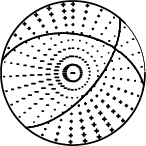
|
|
|
The best fit as a function of depth is given in the following figure:
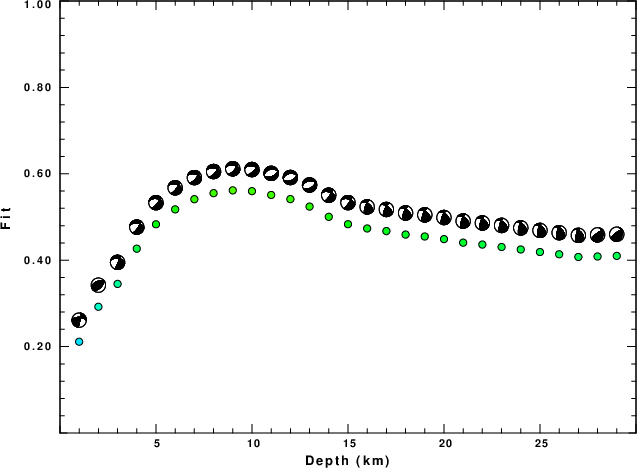
|
|
|
The comparison of the observed and predicted waveforms is given in the next figure. The red traces are the observed and the blue are the predicted. Each observed-predicted component is plotted to the same scale and peak amplitudes are indicated by the numbers to the left of each trace. A pair of numbers is given in black at the right of each predicted traces. The upper number it the time shift required for maximum correlation between the observed and predicted traces. This time shift is required because the synthetics are not computed at exactly the same distance as the observed, the velocity model used in the predictions may not be perfect and the epicentral parameters may be be off. A positive time shift indicates that the prediction is too fast and should be delayed to match the observed trace (shift to the right in this figure). A negative value indicates that the prediction is too slow. The lower number gives the percentage of variance reduction to characterize the individual goodness of fit (100% indicates a perfect fit).
The bandpass filter used in the processing and for the display was
cut o DIST/3.3 -30 o DIST/3.3 +30 rtr taper w 0.1 hp c 0.05 n 3 lp c 0.15 n 3
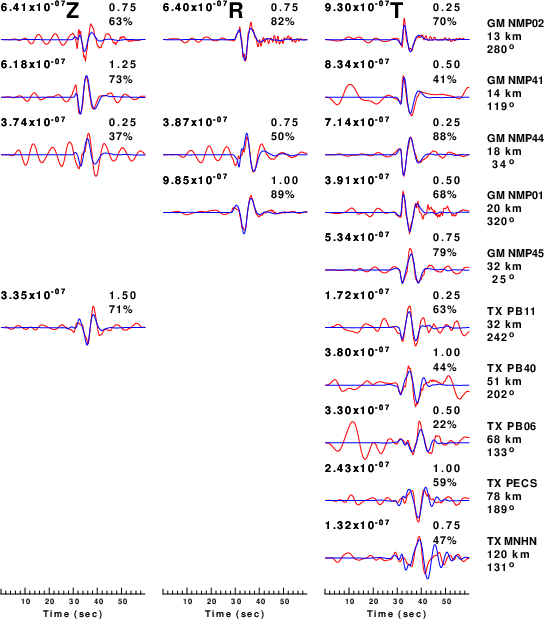
|
| Figure 3. Waveform comparison for selected depth. Red: observed; Blue - predicted. The time shift with respect to the model prediction is indicated. The percent of fit is also indicated. The time scale is relative to the first trace sample. |

|
| Focal mechanism sensitivity at the preferred depth. The red color indicates a very good fit to the waveforms. Each solution is plotted as a vector at a given value of strike and dip with the angle of the vector representing the rake angle, measured, with respect to the upward vertical (N) in the figure. |
A check on the assumed source location is possible by looking at the time shifts between the observed and predicted traces. The time shifts for waveform matching arise for several reasons:
Time_shift = A + B cos Azimuth + C Sin Azimuth
The time shifts for this inversion lead to the next figure:
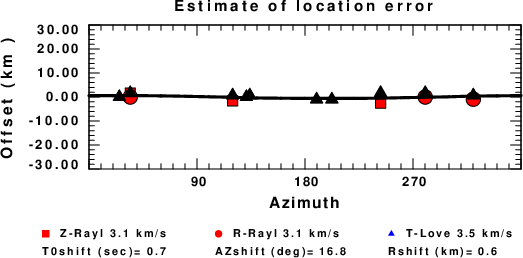
The derived shift in origin time and epicentral coordinates are given at the bottom of the figure.
The WUS.model used for the waveform synthetic seismograms and for the surface wave eigenfunctions and dispersion is as follows (The format is in the model96 format of Computer Programs in Seismology).
MODEL.01
Model after 8 iterations
ISOTROPIC
KGS
FLAT EARTH
1-D
CONSTANT VELOCITY
LINE08
LINE09
LINE10
LINE11
H(KM) VP(KM/S) VS(KM/S) RHO(GM/CC) QP QS ETAP ETAS FREFP FREFS
1.9000 3.4065 2.0089 2.2150 0.302E-02 0.679E-02 0.00 0.00 1.00 1.00
6.1000 5.5445 3.2953 2.6089 0.349E-02 0.784E-02 0.00 0.00 1.00 1.00
13.0000 6.2708 3.7396 2.7812 0.212E-02 0.476E-02 0.00 0.00 1.00 1.00
19.0000 6.4075 3.7680 2.8223 0.111E-02 0.249E-02 0.00 0.00 1.00 1.00
0.0000 7.9000 4.6200 3.2760 0.164E-10 0.370E-10 0.00 0.00 1.00 1.00